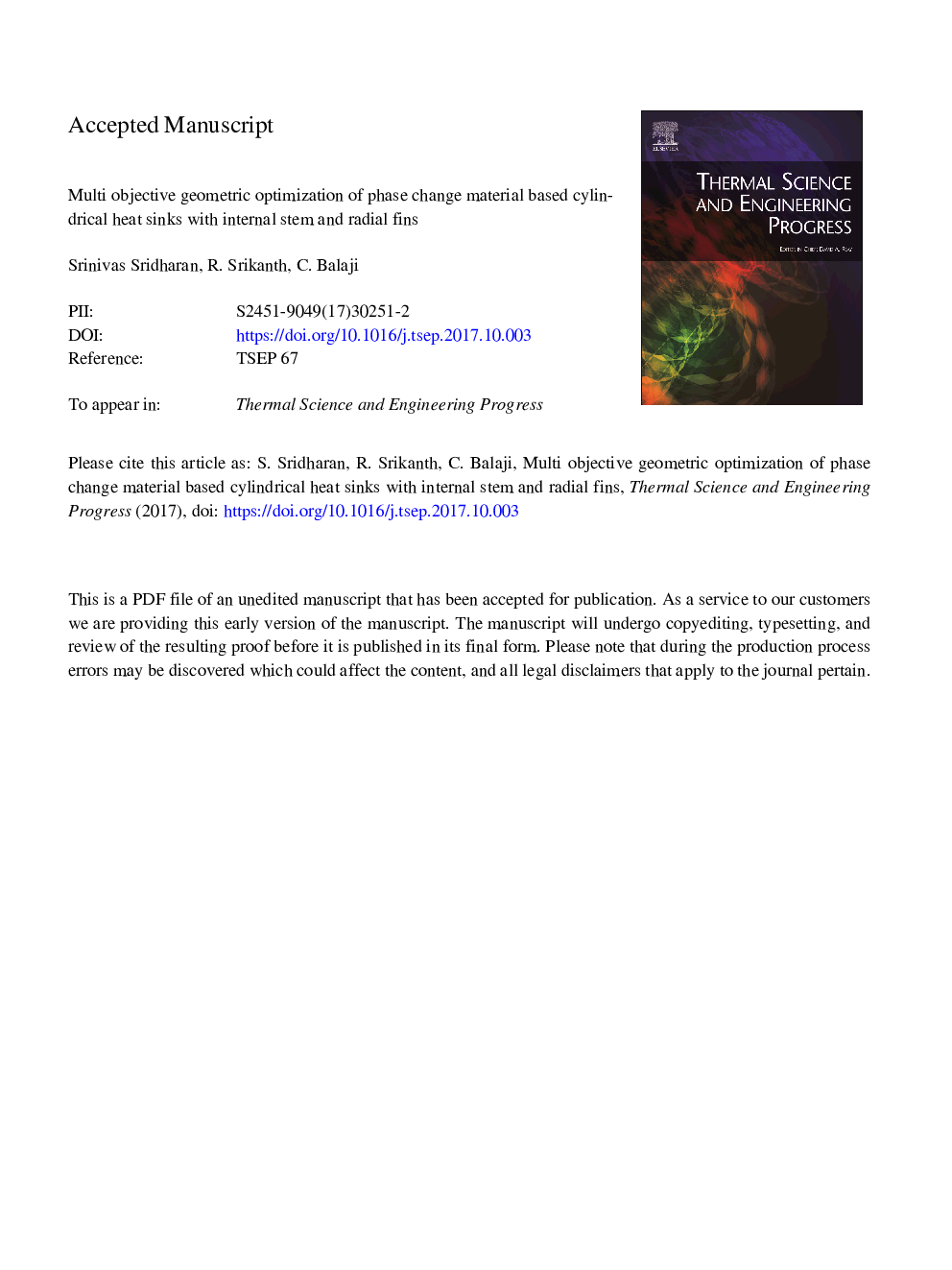| کد مقاله | کد نشریه | سال انتشار | مقاله انگلیسی | نسخه تمام متن |
|---|---|---|---|---|
| 8918781 | 1642858 | 2018 | 63 صفحه PDF | دانلود رایگان |
عنوان انگلیسی مقاله ISI
Multi objective geometric optimization of phase change material based cylindrical heat sinks with internal stem and radial fins
ترجمه فارسی عنوان
بهینه سازی چند منظوره هندسی مواد تغلیظ شده فاز با استوانه گر گرماگیر با استوانه داخلی و باله های شعاعی است
دانلود مقاله + سفارش ترجمه
دانلود مقاله ISI انگلیسی
رایگان برای ایرانیان
کلمات کلیدی
TCEMREPISMSEMOPSOLHSNSGARMSEEDMThermal conductivity enhancersANNSHSPCMpressure staggering optionNiS - NISParticle swarm optimization - بهینه سازی ازدحام ذراتPSO - بهینه سازی ازدحام ذراتMulti objective Optimization - بهینه سازی چند هدفtechnique for order of preference by similarity to ideal solution - تکنیک برای ترتیب اولویت با تشابه به راه حل ایده آلCFD - دینامیک سیالاتComputational fluid dynamics - دینامیک سیالات محاسباتیSensible heat storage - ذخیره گرما معقولPositive ideal solution - راه حل ایده آل مثبتNegative ideal solution - راه حل ایده آل منفیTOPSIS - روش تاپسیسRoot mean square error - ریشه میانگین خطای مربعSIMPLE - سادهArtificial Neural Network - شبکه عصبی مصنوعیartificial neural networks - شبکه های عصبی مصنوعیElectrical Discharge Machining - ماشینکاری الکتریکیPhase change material - مواد تغییر فاز دهندهmean relative error - میانگین خطای نسبیLatin hypercube sampling - نمونه برداری لاتین هپقوبPRESTO - پرستو
موضوعات مرتبط
مهندسی و علوم پایه
مهندسی انرژی
مهندسی انرژی و فناوری های برق
چکیده انگلیسی
This work presents the results of the multi objective geometric optimization of a phase change material (PCM) based cylindrical heat sink with thermal conductivity enhancers (TCEs) in the form of an internal stem with radial fins. The effect of change in the geometric distribution of the TCEs on the performance of the heat sink was studied while maintaining the total volume of TCEs constant. The ratio of the volume of the TCEs to the cavity was also fixed constant at 10%. Initially, experiments were carried out on a cylindrical heat sink with a PCM fill ratio of 99%. A constant heat input of 6â¯W was applied at the bottom of the heat sink through an electrical heater. The PCM used is n-eicosane and the heat sink is made of aluminium. Numerically obtained results from ANSYS Fluent 15.0 were compared with in-house experimental results to determine the heat transfer coefficient from the walls of the heat sink. The heat sink and TCE parameters namely the diameter of the cavity, the height of the cavity, the diameter of the stem, the number of fins and the thickness of fins were treated as design variables. For a constant power level, volume of cavity and volume of TCEs, 25 different geometric configurations (initial population) were generated and the charging and discharging times were obtained as outputs by full three dimensional transient numerical simulations. Artificial Neural Networks (ANNs) were then used to create a fast forward model and multi objective optimization was carried out to obtain the optimal set of geometric configurations which simultaneously maximizes the charging time and minimize the discharging time. The optimal solutions thus obtained were validated with full numerical simulations and were also compared with the initial population. Additional insights into the mechanism of heat transfer and fluid flow were obtained for the problem under consideration.
ناشر
Database: Elsevier - ScienceDirect (ساینس دایرکت)
Journal: Thermal Science and Engineering Progress - Volume 5, March 2018, Pages 238-251
Journal: Thermal Science and Engineering Progress - Volume 5, March 2018, Pages 238-251
نویسندگان
Srinivas Sridharan, R. Srikanth, C. Balaji,
